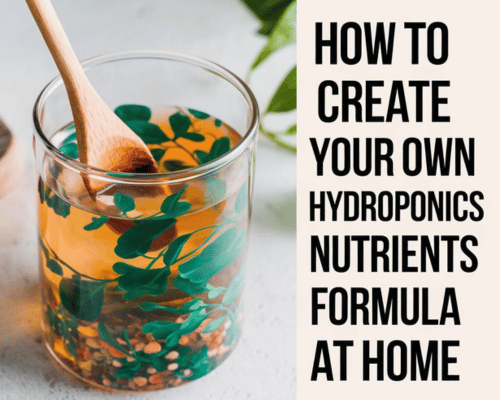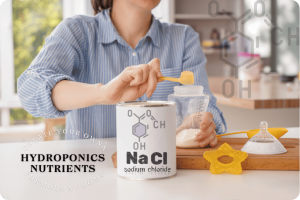
Hydroponic gardening offers numerous benefits, including faster plant growth, higher yields, and the ability to garden indoors. Central to these benefits is the precise management of nutrients crucial for plant health and productivity. Creating your own hydroponics nutrients formula allows you to tailor the nutrient mix to your plant’s needs, ensuring optimal growth and vitality. In this article, you’ll learn how to mix your nutrient solutions at home, gaining the knowledge and confidence to take control of your hydroponic garden’s nutritional needs for better results.
Hydroponics Nutrients Formula for Different Growth Stages: Seedling to Harvest
Different growth stages in hydroponic gardening require specific nutrient ratios to ensure healthy development from seedlings to harvest.
Seedling Stage: At this stage, young plants require lower nutrient concentrations. A balanced formula with a higher ratio of phosphorus (P) supports root development. An ideal mix could be N-P-K at 2-1-2, ensuring tender roots receive gentle nourishment.
Vegetative Stage: During vegetative growth, plants demand more nitrogen (N) to support leafy growth and stem strength. A nutrient formula of N-P-K at 3-1-2 or 4-1-2 is ideal, promoting lush foliage and robust structure.
Flowering and Fruiting Stage: In the flowering and fruiting stages, plants shift their nutrient needs towards more phosphorus (P) and potassium (K) to support bloom and fruit development. A formula such as N-P-K at 1-2-3 is effective, enhancing bud formation and fruit size.
Adjusting your hydroponic nutrient mix according to these growth stages ensures your plants receive the optimal nutrition required for each phase, leading to healthier and more productive harvests.
Plant Nutrient Requirements
Essential Nutrients
Plants require a balanced mix of macro and micronutrients for optimal growth. Macronutrients are needed in larger quantities, while micronutrients are required in smaller amounts but are equally vital.
- Nitrogen (N): Crucial for leaf and stem growth, nitrogen is a primary component of chlorophyll, aiding in photosynthesis.
- Phosphorus (P): Supports root development and energy transfer, playing a key role in flowering and fruiting.
- Potassium (K): Regulates various physiological processes, enhances disease resistance, and improves fruit quality.
- Calcium (Ca): Important for cell wall structure and stability, aiding in root and leaf development.
- Magnesium (Mg): Central element of chlorophyll, essential for photosynthesis and enzyme activation.
- Sulfur (S): Integral for amino acid production and overall plant metabolism.
- Micronutrients: Elements like iron (Fe), manganese (Mn), zinc (Zn), copper (Cu), boron (B), and molybdenum (Mo) are needed in trace amounts but are crucial for enzyme function and nutrient assimilation.
Nutrient Functions
Each nutrient plays a specific role in plant development, influencing various growth stages and overall plant health.
- Nitrogen (N): Promotes vigorous vegetative growth and lush green foliage.
- Phosphorus (P): Encourages strong root systems, enhances flowering, and boosts fruit and seed production.
- Potassium (K): Improves water regulation, enhances photosynthesis, and increases resistance to diseases and environmental stress.
- Calcium (Ca): Strengthens cell walls, preventing diseases and improving the structural integrity of plants.
- Magnesium (Mg): Vital for chlorophyll production and photosynthesis, supporting overall plant vigor.
- Sulfur (S): Crucial for synthesizing proteins and vitamins, contributing to robust plant growth.
- Micronutrients: Facilitate essential biochemical reactions, support enzyme function, and aid in nutrient absorption and transport.
Ingredients and Supplies Needed
Basic Ingredients
Creating your hydroponics nutrient formula requires a range of basic ingredients, primarily consisting of essential chemicals and compounds. These ingredients provide the necessary macro and micronutrients that plants need for optimal growth.
Examples
Potassium Nitrate: Supplies both potassium and nitrogen, crucial for plant vigor and disease resistance.
Calcium Nitrate: Provides calcium and nitrogen, essential for cell wall strength and overall plant structure.
Magnesium Sulfate (Epsom Salt): Delivers magnesium and sulfur, vital for chlorophyll production and enzyme activation.
Monoammonium Phosphate: A source of phosphorus and nitrogen, promoting root development and flowering.
Trace Element Mix: Ensures plants receive micronutrients like iron, manganese, zinc, copper, and boron, which are essential for various metabolic processes.
Equipment
To mix and store your hydroponic nutrients formula effectively, you’ll need a set of specific tools. These tools ensure accurate measurement, proper mixing, and storage of the nutrient solution, maintaining its efficacy and longevity.
Examples
Measuring Spoons: Accurate measurements of nutrient compounds are critical for creating a balanced formula.
Mixing Containers: Use clean, non-reactive containers for mixing and dissolving nutrient powders.
pH Meter: Monitoring and adjusting the pH of the nutrient solution is essential for optimal nutrient uptake by plants.

Storage Bottles: Airtight, labeled bottles for storing mixed nutrient solutions, protecting them from contamination and degradation.
Protective Gear: Gloves and safety goggles to ensure safe handling of chemicals.
Digital Scale: For precise measurement of nutrient powders, ensuring consistency in each batch.
By gathering these basic ingredients and essential tools, you’ll be well-equipped to create and maintain your own hydroponics nutrients formula, ensuring your plants receive the best possible care.
Step-by-Step Guide to Mixing Nutrients
Preparation
Before starting the mixing process, it’s crucial to take appropriate safety precautions and set up your workspace correctly to ensure a safe and efficient nutrient formulation.
Wearing Gloves: Use chemical-resistant gloves to protect your skin from potential irritation caused by nutrient compounds.
Working in a Ventilated Area: Ensure good ventilation to avoid inhaling any dust or fumes from the chemicals.
Protective Gear: Wear safety goggles to shield your eyes and an apron to protect your clothing.
Clean Workspace: Prepare a clean, clutter-free area to prevent contamination of your nutrient mix.
Mixing the Formula
Step 1: Measure and Mix Macronutrients
Measure: Use a digital scale to measure precise amounts of macronutrients like potassium nitrate, calcium nitrate, and magnesium sulfate.
Mix: Dissolve each macronutrient separately in a small amount of warm water before combining them in a larger container.
Step 2: Measure and Mix Micronutrients
Measure: Accurately measure the required amounts of micronutrients, such as iron, manganese, zinc, and copper, using measuring spoons.
Mix: Mix each micronutrient in water separately, ensuring they are fully dissolved before adding them to the macronutrient solution.
Step 3: Adjusting pH Levels
Test pH: Use a pH meter to test the solution’s pH.
Adjust pH: If necessary, add pH up or pH down solutions to achieve the desired pH level (typically between 5.5 and 6.5 for most hydroponic systems).
Storage and Usage
Proper storage and handling of your nutrient solution are essential to maintain its effectiveness and ensure the health of your plants.
Labeling: Clearly label each storage container with the nutrient mix’s contents and the date of preparation.
Shelf Life: Store nutrient solutions in a cool, dark place to extend their shelf life, typically up to a few months.
Application Tips: Use the nutrient solution according to your hydroponic system’s requirements, regularly checking and adjusting the pH and nutrient concentration to meet your plants’ needs.
By following these steps, you can effectively create and manage your own hydroponics nutrients formula, ensuring your plants receive the optimal nutrition for healthy growth.
Common Mistakes in Mixing Hydroponics Nutrients Formula and How to Avoid Them
Incorrect Measurements
Mistake: Using inaccurate measurements of nutrients can lead to imbalances, causing deficiencies or toxicities.
Solution: Always use precise measuring tools such as digital scales and measuring spoons to ensure accurate nutrient ratios.
Improper Mixing Order
Mistake: Adding all nutrients at once can cause chemical reactions that precipitate nutrients, making them unavailable to plants.
Solution: Dissolve each nutrient separately in water before combining. Start with macronutrients, followed by micronutrients.
Ignoring pH Levels
Mistake: Failing to monitor and adjust the pH can prevent plants from absorbing nutrients efficiently.
Solution: Regularly test the nutrient solution’s pH with a pH meter and adjust it to the optimal range (typically 5.5 to 6.5) using pH up or pH down solutions.
Using Contaminated Equipment
Mistake: Contaminated mixing tools and containers can introduce harmful substances to the nutrient solution.
Solution: Clean all equipment thoroughly before use to prevent contamination.
Incorrect Storage
Mistake: Storing nutrient solutions improperly can degrade their quality and effectiveness.
Solution: Store solutions in labeled, airtight containers in a cool, dark place to maintain their potency.
Overlooking Water Quality
Mistake: Using water with high mineral content or impurities can affect nutrient balance.
Solution: Use filtered or distilled water to ensure a clean base for your nutrient mix.
Tips for Success
Monitoring Plant Health
Look for signs of nutrient deficiencies or excesses.
Examples: Yellowing leaves (nitrogen deficiency), stunted growth (phosphorus deficiency), and leaf burn (nutrient excess).
Adjusting the Formula
Adjust nutrient ratios based on plant needs.
Examples: Seasonal adjustments (less nitrogen in winter), and growth stage considerations (more phosphorus for seedlings).
In summary, creating your own hydroponics nutrients formula offers precise control over plant nutrition, ensuring optimal growth and health. By following careful steps in preparation, mixing, and monitoring, you can tailor nutrient solutions to meet specific plant needs effectively. I encourage you to experiment with mixing your formulas – it’s a rewarding way to enhance your hydroponic gardening experience. Share your successes and insights in the comments below, and stay tuned for more valuable tips and updates on hydroponic gardening.

Hey There, I’m Monica, Mom of two. This is my personal blog site. Here I write about Kitchen Tips Tricks, Recipes, and Review the products I use.
I hope you enjoy the article. Give me feedback on how I’m doing with my blog. I would appreciate it so much.
Have a great day! 🙂
[Follow me on Twitter]


